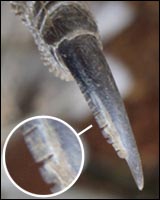 |
 |
 |
Young
nestling |
Adult
Female & Male |
Juvenile |
The Eastern Barn Owl, the only tytonid owl found in eastern Canada, is easily distinguished from other owl species. Barn Owls have heart-shaped facial discs and dark, almost black eyes. Both sexes are ochre to cinnamon above, with patches and speckles of deeper browns. While males have ghostly white faces, breasts, bellies and underwings, females have rusty facial discs and rusty, spotted bellies and underwings (see above). They lack ear-tufts. Eastern Barn Owls are larger and lighter than their western counterparts. Unlike most owls in North America, they have almost bare feet.
The Barn Owl is currently on the COSEWIC (Committee on the Status of Endangered Wildlife in Canada) endangered species list, a curious fact as this species is extremely prolific and can have several clutches in a single year. In fact, Canada is at the northern end of its range due to the cold winter temperatures. The Barn Owl inhabits open country; feeding on field rodents and (since the colonization of Canada) utilizing warmth generated in barns by farm animals. Unfortunately, as technology has advanced, habitiat loss has occurred. In recent years humans have exchanged working animals for mechanical vehicles and pastureland for row crops. The average family that once required horses to travel has forgone them for cars. Therefore there are fewer warm barns for the owls to breed in and less animal feed for their prey (mice and rats) to thrive on. Luckily, Barn Owls are still common in states where livestock farming is predominant and barns and animal feed are accessible.
The Tytonidae family is also unique among owls for having what is known as a "pectinate claw". This is a comb-like, serrated structure that runs along the inner talon edge of the third digit. It is generally thought to aid in preening and is also found on herons, egrets, bitterns and nightjars. Vocalizations: Barn Owls do not hoot. A variety of noises can be produced and many of these are variant screams. Nestling chicks hiss during feeding and when threatened - an offputing sound for any predator. The blood-curdling scream from a Barn Owl is extremely loud. It is no wonder that this ghostly, nocturnal owl was once associated with superstition and death. |
|
|
Vocalizations |
||
|
|
||
| Reaping produced by an owl chick within hours of hatching. | ||
Newborn
Cries |
||
| The snake-like hissing cries produced by two sibling owlets. | ||
Nestling
Chick |
||
This
is a shorter scream produced by a sub-adult owl at dusk. |
||
Short
Scream |
||
|
|
||
|
|
||
Contact
Us | Hours | Home
| Legal
© 2008 The Owl Foundation
Owl vocalizations recorded by Kara Kristjanson.
Unless otherwise stated, all photographs and sound files are the property of The Owl Foundation.
No images or sounds on this website are to be duplicated in any way without express written permission
from the party to which they belong.
If you are interested in receiving quality versions, please contact The Owl Foundation.
